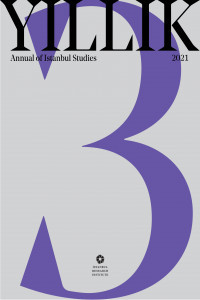Aykırı Bir Arzu Söylemi: Küsname
küsname, osmanlı elyazmaları, osmanlı edebiyatı, cafer çelebi
A Radical Discourse of Desire: Küsnâme
cafer çelebi, küsname, ottoman literature, ottoman manuscripts,
___
- 1 Mecmua-i Baldırzâde, Suna and İnan Kıraç Foundation Manuscript Collection, SVIKV, İAE ŞR 525/9, 140b-141b. The mecmua also includes fatwas from Ebussuud (d. 1574) and other Islamic jurists; waqf deeds, song, poems, prayers, translations of hadiths, Quranic suras, letters; Turkish, Arabic, Azerbaijani, and Persian notes and quotations; copies of imperial edicts; biographical notes on the members of Baldırzâde family, etc. For a full list of the contents, see Günay Kut et al., eds., İstanbul Araştırmaları Enstitüsü Yazma Eserler Kataloğu, v. 1 (İstanbul: İstanbul Araştırmaları Enstitüsü, 2014), 1346-1356. The manuscript is currently displayed at the Memories of Humankind: Stories from the Ottoman Manuscripts exhibition (October 18, 2019 – July 25, 2020) at the Istanbul Research Institute.
- 2 For a detailed introduction of this manuscript, see Fatma Büyükkarcı Yılmaz, “On yedinci yüzyıldan bir kırkambar: Baldırzâde ailesine ait bir mecmua,” Turkish Studies 8, no. 1 (2013): 549-578. Along with descriptions and quotations from various works found in the miscellaneous collection, this article also includes a description of the “Nâme-i Tâcîzâde Cafer Çelebi” and suggests it as the “Küsnâme.” The article also includes transcriptions of a selected 49 couplets from the work (p. 559-564).
- 3 Âşık Çelebi, Meşâ‘irü’ş-şu‘arâ, ed. Filiz Kılıç (İstanbul: İstanbul Araştırmaları Enstitüsü, 2010), 460-461.
- 4 Gözüm yaşını döndürdün bınara, koçaklasam seni çeksem kenara, 141a.
- 5 Gümüş sandukaya iy cân-ı cânân, revân itsem hadeng-i la‘l-peykân, 141a.
- 6 Âşık Çelebi, Meşâ‘irü’ş-şu‘arâ, 460.
- ISSN: 2687-5012
- Başlangıç: 2012
- Yayıncı: Suna ve İnan Kıraç Vakfı Kültür ve Sanat İşletmesi
İstanbul’da On Yedinci Yüzyıl Evlerinde Yaşama Mekânları
Hotels and Highways: The Construction of Modernization Theory in Cold War Turkey
Dönemlendirme Çalışmaları ve Osmanlı-Türk Müziği Tarihyazımı: Bir Bilanço Denemesi
Seeds of Power: Exploration in Ottoman Environmental History. Winwick: The White Horse Press
Osmanlı Döneminde Yerebatan Sarnıcı ve Mahallesi
Rejimin Sessiz Bekçileri: Topkapı Sarayı’nın ‘Kayıp’ Karakolları
10. Milletlerarası Bizans Tetkikleri Kongresi, İstanbul, 15-21 Eylül 1955
